The contribution of psychosocial stress to the obesity epidemic: an evolutionary approach
- PMID: 19156597
- PMCID: PMC2703181
- DOI: 10.1055/s-0028-1119377
The contribution of psychosocial stress to the obesity epidemic: an evolutionary approach
Erratum in
- Horm Metab Res. 2009 Apr;41(4):270
Abstract
The Thrifty Gene hypothesis theorizes that during evolution a set of genes has been selected to ensure survival in environments with limited food supply and marked seasonality. Contemporary environments have predictable and unlimited food availability, an attenuated seasonality due to artificial lighting, indoor heating during the winter and air conditioning during the summer, and promote sedentariness and overeating. In this setting the thrifty genes are constantly activated to enhance energy storage. Psychosocial stress and sleep deprivation are other features of modern societies. Stress-induced hypercortisolemia in the setting of unlimited food supply promotes adiposity. Modern man is becoming obese because these ancient mechanisms are efficiently promoting a positive energy balance. We propose that in today's plentifully provisioned societies, where sedentariness and mental stress have become typical traits, chronic activation of the neuroendocrine systems may contribute to the increased prevalence of obesity. We suggest that some of the yet unidentified thrifty genes may be linked to highly conserved energy sensing mechanisms (AMP kinase, mTOR kinase). These hypotheses are testable. Rural societies that are becoming rapidly industrialized and are witnessing a dramatic increase in obesity may provide a historical opportunity to conduct epidemiological studies of the thrifty genotype. In experimental settings, the effects of various forms of psychosocial stress in increasing metabolic efficiency and gene expression can be further tested.
Figures
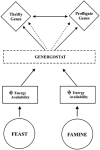
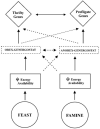
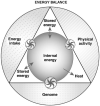
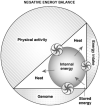
 Fig. 3. The size of the arrows of the wheels is proportional to the effect and the direction of the arrows indicates the movement of the energy fluxes. Wheels represent the regulatory interactions between the three components (genome, physical activity, energy intake) and the mechanisms controlling the internal energy.
Fig. 3. The size of the arrows of the wheels is proportional to the effect and the direction of the arrows indicates the movement of the energy fluxes. Wheels represent the regulatory interactions between the three components (genome, physical activity, energy intake) and the mechanisms controlling the internal energy.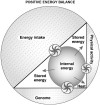
 Fig. 3. The size of the arrows of the wheels is proportional to the effect and the direction of the arrows indicates the movement of the energy fluxes. Wheels represent the regulatory interactions between the three components (genome, physical activity, energy intake) and the mechanisms controlling the internal energy.
Fig. 3. The size of the arrows of the wheels is proportional to the effect and the direction of the arrows indicates the movement of the energy fluxes. Wheels represent the regulatory interactions between the three components (genome, physical activity, energy intake) and the mechanisms controlling the internal energy.
 Fig. 3. Double arrows (↔) indicate reciprocal influences. Wheels are non-energetic, regulatory interactions between the three components (genome, physical activity, energy intake) and the mechanisms controlling the internal energy.
Fig. 3. Double arrows (↔) indicate reciprocal influences. Wheels are non-energetic, regulatory interactions between the three components (genome, physical activity, energy intake) and the mechanisms controlling the internal energy.References
-
- Last J. A Dictionary of Epidemiology. 4th ed. Oxford University Press; Oxford: 2001.
-
- Kac G. Secular height trend: a literature review. Cad Saude Publica. 1999;15:451–461. - PubMed
-
- Wattigney WA, Srinivasan SR, Chen W, Greenlund KJ, Berenson GS. Secular trend of earlier onset of menarche with increasing obesity in black and white girls: the Bogalusa Heart Study. Ethn Dis. 1999;9:181–189. - PubMed
-
- Lynn Matton ND, Wijndaele K, Philippaerts R, Duquet W, Beunen G, Claessens AL, Thomis M, Lefevre J. Secular trends in anthropometric characteristics, physical fitness, physical activity, and biological maturation in Flemish adolescents between 1969 and 2005. Am J Hum Biol. 2007;19:345–357. - PubMed
-
- Flegal KMCM, Kuczmarski RJ, Johnson CL. Overweight and obesity in the United States: prevalence and trends, 1960-1994. Int J Obes Relat Metab Disord. 1998;22:39–47. - PubMed
Publication types
MeSH terms
Grants and funding
LinkOut - more resources
Full Text Sources
Medical
Miscellaneous

